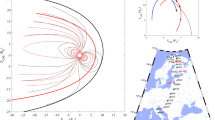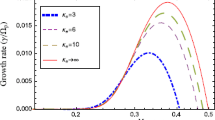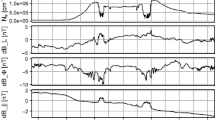Abstract
By using theoretical models of plasma dynamics, it is possible to reconstruct the evolution of many magnetospheric processes; nevertheless, these models need the support of both electric and magnetic field models, and they can simulate known processes only. Conversely, the empirical models are mainly based on statistical analysis; hence, they start from observations, not from processes. Statistical analyses and the derived empirical models are important complements to theoretical models and simulations since the former represent the actual conditions. The empirical models of the inner magnetosphere ion distribution MODEM and of the pitch angle distribution PADEM have proved to be successful in deriving average features of the ring current as well as in obtaining the long-term development of the ion distributions during quiet and disturbed periods. The major goals of this approach are: (1) the description of the equatorial proton population during quiet times and the quantitative characterization of their spatial and energetic distribution; (2) the evidence of some key features of the proton distribution strictly connected to the solar wind characteristics; (3) the investigation of the evolution of magnetospheric ion populations during geomagnetic disturbances and their role in the ring current development. In this paper we review the above-mentioned studies.
Similar content being viewed by others
Explore related subjects
Discover the latest articles and news from researchers in related subjects, suggested using machine learning.References
Acuña, M.H., K.W. Ogilvie, D.N. Baker, S.A. Curtis, D.H. Fairfield, and W.H. Mish (1995), The Global Geospace Science Program and its investigations, Space Sci. Rev. 71, 1–4, 5–21, DOI: 10.1007/BF00751323.
Bame, S.J., D.J. McComas, M.F. Thomsen, B.L. Barraclough, R.C. Elphic, J.P. Glore, J.T. Gosling, J.C. Chavez, E.P. Evans, and F.J. Wymer (1993), Magnetospheric plasma analyzer for spacecraft with constrained resources, Rev. Sci. Instrum. 64, 4, 1026, DOI: 10.1063/1.1144173.
Belian, R.D., G.R. Gisler, T. Cayton, and R. Christensen (1992), High-Z energetic particles at geosynchronous orbit during the great solar proton event series of October 1989, J. Geophys. Res. 97, A11, 16,897–16,906, DOI: 10.1029/92JA01139.
Daglis, I.A., E.T. Sarris, and G. Kremser (1990), Indications for ionospheric participation in the substorm process from AMPTE/CCE observations, Geophys. Res. Lett. 17, 1, 57–60, DOI: 10.1029/GL017i001p00057.
De Benedetti, J., A. Milillo, S. Orsini, A. Mura, E. De Angelis, and I.A. Daglis (2005), Empirical model of the inner magnetosphere H+ pitch angle distributions. In: T. Pulkkinen, N. Tsyganenko, and R. Friedel (eds.), The Inner Magnetosphere: Physics and Modelling, AGU Monograph Series 38, 283–291, AGU, Washington, D.C.
De Michelis, P., I.A. Daglis, and G. Consolini (1999), An average image of proton plasma pressure and of current systems in the equatorial plane derived from AMPTE/CCE-CHEM measurements, J. Geophys. Res. 104, 28615–28624, DOI: 10.1029/1999JA900310.
Dessler, A.J., and E.N. Parker (1959), Hydromagnetic theory of geomagnetic storms, J. Geophys. Res. 64, 12, 2239–2252, DOI: 10.1029/JZ064i012p02239.
Ebihara, Y., and M. Ejiri (2000), Simulation study on fundamental properties of the storm-time ring current, J. Geophys. Res. 105, A7, 15,843–15,859, DOI: 10.1029/1999JA900493.
Ebihara, Y., M. Ejiri, H. Nilsson, I. Sandahl, A. Milillo, M. Grande, J.F. Fennel, and J.L. Roeder (2002), Statistical distribution of the storm-time proton ring current: POLAR measurements, Geophys. Res. Lett. 29, 20, 1969, DOI: 10.1029/2002GL015430.
Ejiri, M. (1978), Trajectory traces of charged particles in the magnetosphere, J. Geophys. Res. 83, A10, 4798–4810, DOI: 10.1029/JA083iA10p04798.
Fok, M.-C., T.E. Moore, J.U. Kozyra, G.C. Ho, and D.C. Hamilton (1995), Three-dimensional ring current decay model, J. Geophys. Res. 100, A6, 9619–9632, DOI: 10.1029/94JA03029.
Fok, M.-C., T.E. Moore, and M.E. Greenspan (1996), Ring current development during storm main phase, J. Geophys. Res. 101, A7, 15,311–15,322, DOI: 10.1029/ 96JA01274.
Fok, M.-C., R.A. Wolf, R.W. Spiro, and T.E. Moore (2001), Comprehensive computational model of Earth’s ring current, J. Geophys. Res. 106, A5, 8417–8424, DOI: 10.1029/2000JA000235.
Ganushkina, N.Y., T.I. Pulkkinen, and T. Fritz (2005), Role of substorm-associated impulsive electric fields in the ring current development during storms, Ann. Geophys. 23, 579–591.
Ganushkina, N.Y., T.I. Pulkkinen, A. Milillo, and M. Liemohn (2006), Evolution of the proton ring current energy distribution during April 21–25, 2001 storm, J. Geophys. Res. 111, A11S08, DOI: 10.1029/2006JA011609.
Gloeckler, G., F.M. Ipavich, W. Studemann, B. Wilken, D.C. Hamilton, G. Kremser, D. Hovestadt, F. Gliem, R.A. Lundgren, W. Rieck, E.O. Tums, J.C. Cain, L.S. Masung, W. Weiss, and P. Winterhof (1985), The Charge-Energy-Mass spectrometer for 0.3–300 keV/e ions on the AMPTE/CCE, IEEE Trans. Geosci. Remote Sens. GE-23, 234–240, DOI: 10.1109/TGRS.1985.289519.
Jordanova, V.K., L.M. Kistler, J.U. Kozyra, G.V. Khazanov, and A.F. Nagy (1996), Collisional losses of ring current ions, J. Geophys. Res. 101, A1, 111–126, DOI: 10.1029/95JA02000.
Jordanova, V.K., L.M. Kistler, C.J. Farrugia, and R.B. Torbert (2001), Effects of inner magnetospheric convection on ring current dynamics: March 10–12, 1998, J. Geophys. Res. 106, A12, 29,705–29,720, DOI: 10.1029/2001JA000047.
Kistler, L.M., F.M. Ipavich, D.C. Hamilton, G. Gloeckler, B. Wilken, G. Kremser, and W. Stüdemann (1989), Energy spectra of the major ion species in the ring current during geomagnetic storms, J. Geophys. Res. 94, A4, 3579–3599, DOI: 10.1029/JA094iA04p03579.
Korth, A., G. Kremser, A. Roux, S. Perraut, J.-A. Sauvaud, J.-M. Bosqued, A. Pedersen, and B. Aparicio (1983), Drift boundaries and ULF wave generation near noon at geostationary orbit, Geophys. Res. Lett. 10, 8, 639–642, DOI: 10.1029/GL0l0i008p00639.
Korth, H., M.F. Thomsen, J.E. Borovsky, and D.J. McComas (1999), Plasma sheet access to geosynchronous orbit, J. Geophys. Res. 104, A11, 25,047–25,061, DOI: 10.1029/1999JA900292.
Liemohn, M.W., J.U. Kozyra, M.F. Thomsen, J.L. Roeder, G. Lu, J.E. Borovsky, and T.E. Cayton (2001a), Dominant role of the asymmetric ring current in producing the stormtime Dst, J. Geophys. Res. 106, A6, 10,883–10,904, DOI: 10.1029/2000JA000326.
Liemohn, M.W., J.U. Kozyra, C.R. Clauer, and A.J. Ridley (2001b), Computational analysis of the near-Earth magnetospheric current system during two-phase decay storms, J. Geophys. Res. 106, A12, 29,531–29,542, DOI: 10.1029/2001JA000045.
Lui, A.T.Y., and D.C. Hamilton (1992), Radial profiles of quiet time magnetospheric parameters, J. Geophys. Res. 97, 19,325–19,332, DOI: 10.1029/92JAO1539.
McComas, D.J., S.J. Bame, B.L. Barraclough, J.R. Donart, R.C. Elphic, J.T. Gosling, M.B. Moldwin, K.R. Moore, and M.F. Thomsen (1993), Magnetospheric plasma analyzer: Initial three-spacecraft observations from geosyncronous orbit, J. Geophys. Res. 98, A8, 13,453–13,465, DOI: 10.1029/93JA00726.
McIlwain, C.E. (1986), A Kp dependent equatorial electric field model, Adv. Space Res. 6, 3, 187–197.
Milillo, A., and M.F. Marcucci (2007), Plasma sheet during dual lobe reconnection: a case study, IUGG XXIV General Assembly, Perugia, Italy, 2–13 July 2007, “Earth: Our Changing Planet”, poster.
Milillo A., S. Orsini, I.A. Daglis, S. Livi (1999), An empirical model of the ion distributions in the equatorial inner magnetosphere, Phys. Chem. Earth, Part C 24, 1–3, 209–214, DOI: 10.1016/S1464-1917(98)00030-0.
Milillo, A., S. Orsini, and I.A. Daglis (2001), Empirical model of proton fluxes in the equatorial inner magnetosphere: Development, J. Geophys. Res. 106, A11, 25,713–25,729, DOI: 10.1029/2000JA900158.
Milillo, A., S. Orsini, D.C. Delcourt, A. Mura, S. Massetti, E. De Angelis, and Y. Ebihara (2003), Empirical model of proton fluxes in the equatorial inner magnetosphere: 2. Properties and applications, J. Geophys. Res. 108, A5, 1165, DOI: 10.1029/2002JA009581.
Milillo, A., S. Orsini, S. Massetti, and A. Mura (2006), Geomagnetic activity dependence of the inner magnetospheric proton distribution: An empirical approach for the 21–25 April 2001 storm, J. Geophys. Res. 111, A11S13, DOI: 10.1029/2006JA011956.
Milillo, A., M.F. Marcucci, and D. Delcourt (2008), Plasma sheet evolution following dual lobe reconnection, EGU General Meeting, Vienna, Austria, 13–18 April 2008.
Orsini, S., I.A. Daglis, M. Candidi, K.C. Hsieh, S. Livi, and B. Wilken (1994), Model calculation of energetic neutral atoms precipitation at low altitudes, J. Geophys. Res. 99, A7, 13,489–13,498, DOI: 10.1029/93JA03270.
Orsini, S., A. Milillo, and A. Mura (2004), Modeling the time-evolving plasma in the inner magnetosphere: An empirical approach, J. Geophys. Res. 109, A11216, DOI: 10.1029/2004JA010532.
Roederer, J.G. (1967), On the adiabatic motion of energetic particles in a model magnetosphere, J. Geophys. Res. 72, 3, 981–992, DOI: 10.1029/JZ072i003p00981.
Roeder, J.L., M.W. Chen, J.F. Fennell, and R. Friedel (2005), Empirical models of the low-energy plasma in the inner magnetosphere, Space Weather 3, S12B06, DOI: 10.1029/2005SW000161.
Sckopke, N. (1966), A general relation between the energy of trapped particles and the disturbance field over the Earth, J. Geophys. Res. 71, 3125–3130.
Sheldon, R.B., and D.C. Hamilton (1993), Ion transport and loss in the Earth’s quiet ring current, 1. Data and standard model, J. Geophys. Res. 98, A8, 13,491–13508, DOI: 10.1029/92JA02869.
Vallat, C., N. Ganushkina, I. Dandouras, C.P. Escoubet, M.G.G.T. Taylor, H. Laakso, A. Massonı, J.-A. Sauvaud, H. Rème, and P. Daly (2007), Ion multinose structures observed by Cluster in the inner Magnetosphere, Ann. Geophys. 25, 171–190.
West, H.I.Jr., R.M. Buck, and J.R. Walton (1973), Electron pitch angle distributions throughout the magnetosphere as observed on Ogo 5, J. Geophys. Res. 78, 7, 1064–1081, DOI: 10.1029/JA078i007p01064.
Wilken, B., W. Weiss, D. Hall, M. Grande, F. Soraas, and J.F. Fennell (1992), Magnetospheric ion composition spectrometer onboard the CRRES spacecraft, J. Spacecr. Rockets 29, 4, 585–591, DOI: 10.2514/3.25503.
Zhang, Y., L.J. Paxton, T.J. Immel, H.U. Frey, and S.B. Mende (2003), Sudden solar wind dynamic pressure enhancements and dayside detached auroras: IMAGE and DMSP observations, J. Geophys. Res. 108, A4, 8001, DOI: 10.1029/2002JA009355.
Zhang, Y., L.J. Paxton, C.-I. Meng, D. Morrison, B. Wolven, H. Kil, and A.B. Christensen (2004), Double dayside detached auroras: TIMED/GUVI observations, Geophys. Res. Lett. 31, L10801, DOI: 10.1029/2003GL018949.
Author information
Authors and Affiliations
Corresponding author
Rights and permissions
About this article
Cite this article
Milillo, A., Orsini, S. Empirical modeling of the ring current. Acta Geophys. 57, 171–184 (2009). https://doi.org/10.2478/s11600-008-0063-5
Received:
Accepted:
Published:
Issue Date:
DOI: https://doi.org/10.2478/s11600-008-0063-5




